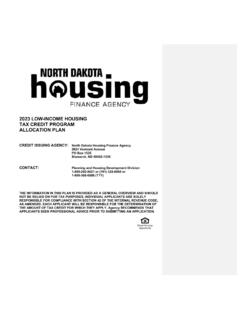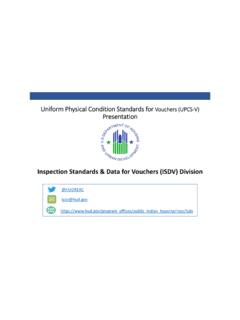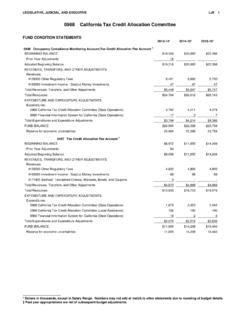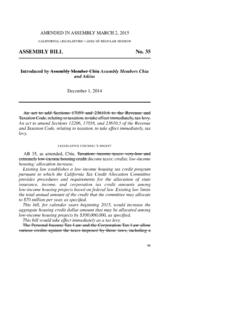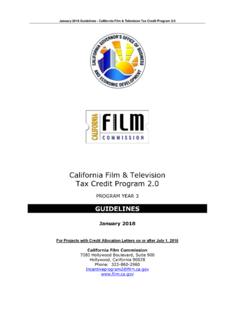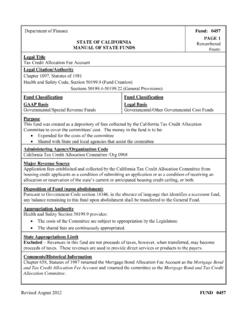Transcription of 2015-2016 LOW INCOME HOUSING TAX CREDIT PROGRAM …
1 2015-2016 LOW INCOME HOUSING TAX CREDIT PROGRAM ALLOCATION PLAN CREDIT ISSUING AGENCY: North Dakota HOUSING Finance Agency 2624 Vermont Avenue PO Box 1535 Bismarck, ND 58502-1535 CONTACT: Planning and HOUSING Development Division 1-800-292-8621 or (701) 328-8066 or 1-800-366-6888 (TTY) THE INFORMATION IN THIS PLAN IS PROVIDED AS A GENERAL OVERVIEW AND SHOULD NOT BE RELIED ON FOR TAX PURPOSES. INDIVIDUAL APPLICANTS ARE SOLELY RESPONSIBLE FOR COMPLIANCE WITH SECTION 42 OF THE TAX REFORM ACT OF 1986, AS AMENDED. EACH APPLICANT WILL BE RESPONSIBLE FOR THE DETERMINATION OF THE AMOUNT OF TAX CREDIT FOR WHICH THEY APPLY. NDHFA RECOMMENDS THAT APPLICANTS SEEK PROFESSIONAL ADVICE PRIOR TO SUBMITTING AN APPLICATION.
2 Equal HOUSING Opportunity TABLE OF CONTENTS I. INTRODUCTION 1 II. GENERAL PROVISIONS 1 A. CREDIT Rate 1 B. Eligible Basis 2 C. Maximum Developer Fee 2 D. Maximum Builder/Contractor Fees 2 E. Qualified Basis 3 F. Annual CREDIT Amount 3 G. INCOME and Rent Restrictions 3 H. Extended Low INCOME HOUSING Commitment 3 I. Gross Rent Floor 4 J. Compliance Monitoring 4 K. Restriction 5 L. Discrimination 5 M. ADA and 504 5 N. Limit on Volume 5 O. Recapture 5 P. Reserve Accounts 5 Q. Tax-Exempt Financed Properties 6 R. Identity of Interest 6 S. Disclosure of Interest 6 III. TYPES OF DEVELOPMENTS 6 A. New Construction 7 B. Existing Properties 7 C. Substantial Rehabilitation 7 D. Ineligible Properties 7 IV. APPLICATION PROCESS 8 V.
3 THRESHOLD REQUIREMENTS 9 A. Demonstrated Site Control 9 B. Zoning Availability 9 C. Utilities Availability 9 D. Applicant Characteristics 9 E. Financial Projections 9 F. Ownership 10 G. Subsidies 10 H. Compliance with Fair HOUSING Act 10 I. Public HOUSING Waiting List 10 J. Local Support Letter 10 K. HOUSING Need 10 L. Capital Needs Assessment 10 M. Ability 11 N. Appraisal 11 O. USDA Existing Debt 11 VI. APPLICATION FEES 12 A. For-Profit Applicants 12 B. Non-Profit Applicants 12 C. Tax-Exempt Financed Properties 12 VII. CREDIT RESERVATIONS 12 A. Conditional Reservation 13 B. Formal Reservation 13 C. Property Progress Reports 14 D. CREDIT Return or Cancellation 14 E. Final Allocation of Tax Credits 14 VIII.
4 SET-ASIDES and TARGETED AREAS 15 A. Non-Profit Participation 15 B. Indian Reservation Set-Aside 16 IX. PROPERTY RATINGS 16 A. Serves Lowest INCOME Group Possible 16 B. Extended Duration of Low INCOME Use 17 C. Community Revitalization Project 17 D. Special Needs 17 E. Design Standards 18 F. Green Communities 18 G. Rent Rebate for Homeownership 19 H. Tenant Ownership 19 I. HOUSING for Individuals with Children 19 J. HOUSING for People 55 and Over 19 K. Internet Connection Provided to Tenants 19 L. Preserve Existing Properties 19 M. Committed Leverage 20 N. Geographic Location 20 X. CARRYOVER ALLOCATIONS 21 XI. RESPONSIBILITY OF APPLICANT 21 XII. CLARIFICATION OF AGENCY ROLE 21 XIII. MODIFICATION TO THE QUALIFIED ALLOCATION PLAN 22 North Dakota HOUSING Finance Agency 2624 Vermont Ave PO Box 1535 Bismarck, ND 58502-1535 Ph: 701/328-8080 Fax: 701/328-8090 Toll Free 800/292-8621 800/366-6888 (TTY) Page 1 of 21 NORTH DAKOTA LOW INCOME HOUSING TAX CREDIT PROGRAM 2015-2016 ALLOCATION PLAN I.
5 INTRODUCTION The North Dakota HOUSING Finance Agency (NDHFA) is responsible for the administration of the Low INCOME HOUSING Tax CREDIT (LIHTC) PROGRAM for the State of North Dakota. The LIHTC was established by the Tax Reform Act of 1986 for the purpose of encouraging the construction and rehabilitation of HOUSING for low- INCOME individuals and families. The CREDIT likewise offers a reduction in tax liability to owners and investors. Parties interested in pursuing tax credits should reference Section 42 of the Internal Revenue Code (the "Code") for more detailed information. It is also advisable to seek competent tax counsel for additional guidance. Pursuant to the Budget Reconciliation Act of 1989, NDHFA is required to develop a "Qualified Allocation Plan" defining the process by which it will distribute the Low INCOME HOUSING Tax CREDIT ("the tax CREDIT ") to low INCOME HOUSING properties throughout the State of North Dakota.
6 The NDHFA allocation plan, as herein stated, promotes the selection of those properties which serve to address the most crucial needs of the state, within the guidelines and requirements established by the federal government. NDHFA holds a public hearing in Bismarck on changes to the Allocation Plan and public comments are invited. Testimony and comments are considered from those attending, as well as other information gathered from comments received as the result of a large mailing of the "draft" allocation plan. These comments are then taken into consideration in the formulation of the final plan. II. GENERAL PROVISIONS The NDHFA reserves the right, at its sole discretion, to modify or waive any condition of this plan, which is not mandated by the Code, on a case-by-case basis for good cause.
7 For purposes of this Plan, the Developer is defined as the individual or entity to which the developer fees are paid for promoting the property. The Developer may or may not be the Applicant. The Applicant is either the owner of the property, ( partnership, corporation, limited liability company, etc.) or the entity that has controlling interest in the ownership entity, ( the general partner, managing member, individual, etc.). A. CREDIT Rate: The tax CREDIT is intended to provide, over a 10-year period, a "present value" CREDIT of either of the following: (1) 30 percent of the property's Qualified Basis for new buildings with a federal subsidy or for the acquisition costs of eligible existing buildings that are rehabilitated. A new building is treated as federally subsidized if there is tax-exempt financing.
8 (2) 70 percent of the property's Qualified Basis in the case of new construction or the substantial rehabilitation costs on an acquired building. The Internal Revenue Service publishes, on a monthly basis, the applicable percentage ( CREDIT rate) to be used in calculating the annual CREDIT amount, approximately 4 percent and 9 percent. NDHFA will underwrite 2015 and 2016 applications at the CREDIT rates in affect at the time of the application submission deadline plus a cushion of 20 basis points on the 4 percent rate and 40 basis points on the 9 percent rate. The 9 percent rate is fixed for buildings that received an allocation of credits by North Dakota HOUSING Finance Agency 2624 Vermont Ave PO Box 1535 Bismarck, ND 58502-1535 Ph: 701/328-8080 Fax: 701/328-8090 Toll Free 800/292-8621 800/366-6888 (TTY) Page 2 of 21 December 31, 2013.
9 Should this provision be amended or extended after 2015 allocations are made, funded projects will be considered for a forward commitment of the maximum allowable award. CREDIT is available each year for 10 years. CREDIT is based on the percentage of qualified low- INCOME units in a property or the percentage of floor space of qualified low- INCOME units, whichever is less. Allocations are made to each building regardless of the number of buildings comprising a property. B. Eligible Basis: The eligible basis for a new building is arrived at by taking all costs not allowable under the Code, including land, and subtracting them from the total property cost. The eligible basis for an existing building is the sum of the acquisition cost plus additions and improvements, but only if the building has not been placed-in-service or substantially rehabilitated in the preceding 10 years.
10 For exemptions to this rule, see page 7. Eligible basis is reduced by federal grants, residential rental units which are above the average quality standard of the low- INCOME units, any historical rehabilitation credits, and non-residential rental property. A property located in a Qualified Census Tract (QCT) or HUD designated Difficult Development Area (DDA) is eligible for credits up to 130 percent of eligible basis. Also eligible for consideration for this boost are: (1) projects designed to primarily serve special needs populations, homeless or those requiring permanent supportive services; (2) projects that target 20 percent or more of the units at 30 percent of area median INCOME or less; (3) projects within tribal reservations, including the Trenton Indian Service Area; (4) new construction projects on in-fill lots a) with existing structures which need to be demolished or b) require substantial environmental remediation; and (5) projects in rural areas without sufficient soft financing to be financially feasible in low market rent areas.
